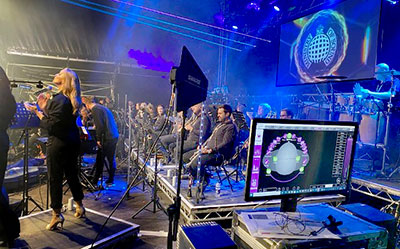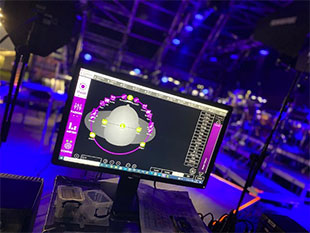The Ministry of Sound Classical (MoS Classical) show – a celebration of 30 years of Ministry of Sound’s favourite dance classics performed by the London Concert Orchestra – returned recently, with the 50-piece orchestra using Klang’s 3D personal monitor mixing system.
 Head of Sound and sound designer since 2018, Phil Wright, has become increasingly familiar with the system over recent months: ‘I’m involved with the 5G Festival, an R&D project that’s working on finding ways to allow musicians to play together with insignificant latency over the 5G network,’ he explains. ‘We’ve been using Klang on that to great effect, finding that working in a 3D environment brought significant advantages to the project.’
Head of Sound and sound designer since 2018, Phil Wright, has become increasingly familiar with the system over recent months: ‘I’m involved with the 5G Festival, an R&D project that’s working on finding ways to allow musicians to play together with insignificant latency over the 5G network,’ he explains. ‘We’ve been using Klang on that to great effect, finding that working in a 3D environment brought significant advantages to the project.’
This positive experience meant that when the series of MoS Classical dates landed in his diary, Wright suggested to RG Jones, who were supplying the show’s audio equipment, that Klang was the ideal monitor system to use and would be a great investment for them.
‘They immediately saw the benefit and purchased two Klang:vokal processors and 12 Klang:kontrollers from HD Pro Audio,’ says Wright, the latter allowing orchestra members of to control their own mixes, sent from Wright’s DiGiCo SD12 96 at FOH, with Associate Head of Sound, Leigh Davies, in charge of the stage, spatialising the individual mixes using the Klang:app.
A key factor in Wright’s choice was Klang:vokal’s ability to handle 64 channels of Dante or Madi, which could be routed from the console’s direct outs and/or submixes, create relative mixing groups, and for every Klang:kontroller panel to be customised to the person using it.
‘As we went through production rehearsals, the benefits became clear to everyone,’ Wright continues. With a busy mix featuring numerous percussive elements and a click track, a standard mixer system would have been a compromise, necessitating knocking something into mono or taking it away; Klang meant he could just keep adding.
‘It also allows us to position the click directly in front of people, rather than having it panned to the centre in stereo, which means they can latch on to and follow it much more easily,’ he continues. ‘It’s very neat and elegant that the backing singers, for example, who have a Klang:kontroller but are on radio in ears, can move about the stage. Previously we’ve had to come out of the mixer panel with a mini jack to two XLRs, then run long XLRs back to the RF pack to get the output of the mixer back into their ears. With Klang, we can output that mix anywhere.
 ‘I sent the mixes over Dante XLR breakout box, housed in the same rack as the in-ear transmitters, thus removing the need for additional cable on stage. It’s a much cleaner solution, and more reliable because you’re not depending on jack to XLRs.’
‘I sent the mixes over Dante XLR breakout box, housed in the same rack as the in-ear transmitters, thus removing the need for additional cable on stage. It’s a much cleaner solution, and more reliable because you’re not depending on jack to XLRs.’
Davies describes his role as 'making sure the stage is solid, ensuring that Wright and the artists are completely comfortable'. The Klang set-up gave him the ability to listen to each mix on the artists’ individual Klang:kontroller, with his own panel mimicking the artist panels from side of stage. This allowed him to work like a monitor engineer and jump on any issues but without a console – a decisive advantage with such a busy stage.
‘With a Klang:kontroller in front of them, if we turn up at festivals, there are deps, or we don’t get a sound check, they need to know their mix is bang on from the first beat of the first bar. Klang gives that to them,’ he says. ‘On a very busy and loud stage there can be too much information. Klang’s 3D environment gives space to each element and the placement of the objects gives a feeling of support. The artists don’t realise what’s going on, which is part of the beauty of it, it just makes everyone’s life easier.’
Although there was no time to rehearse, Wright and Davies spent time with DiGiCo’s Tim Shaxson and the RG Jones team setting the system up and were confident it would work from the off. ‘Thanks to Klang’s association with DiGiCo, the system has a reassuringly DiGiCo infrastructure,’ says Davies. ‘It has the same language and some of the same behaviour patterns and recall parameters. The more we understand how to use the app and the benefits of it, the better it gets and my involvement in the spatial aspect gets bigger.
‘Using Klang gives an acoustic feel on stage. Even though this is EDM and there’s a very noisy crowd of upwards of 5,000 people, the orchestra can perform just as they normally would and with a beautiful dynamic. Everyone really enjoyed it and the crowd went wild.’